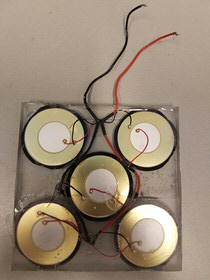Piëzo-elektrische proeftuin in Zuidhorn wekt energie op
Vanmiddag nam de Rijksuniversiteit Groningen een piëzo-proeftuin in gebruik op het Stationspark in Zuidhorn. Piëzo-elektriciteit is energie die wordt opgewekt door trilling. Directeur van CogniGron Prof. dr. Beatriz Noheda en wethouder Hielke Westra van de gemeente Westerkwartier onthulden een tijdelijk informatiebord. Dit bord licht de proefopstelling voor computertechnologie toe en is onderdeel van het Energiepad dat in het stationsgebied van Zuidhorn ligt. De proeftuin maakt onderdeel uit van het CogniGron-onderzoeksprogramma van de RUG op gebied van neuromorphische systemen: de basis voor een nieuwe generatie computers.
De onderzoekers van CogniGron ontwikkelen nieuwe slimme materialen die te gebruiken zijn in op ons brein geïnspireerde computersystemen. Die materialen vragen maar een fractie van de energie die computers momenteel nog gebruiken. Een belangrijk onderdeel hiervan is het piëzo-elektrisch effect. Bij de opstelling in Zuidhorn ligt een tegel die onder invloed van druk, door er bijvoorbeeld op te gaan staan, een elektrische spanning produceert. Door over deze tegel te lopen kan energie worden opgewekt. Tegelijkertijd kunnen de piëzo-tegels ook als sensor worden gebruikt. Het stationsgebied van Zuidhorn is een ideale locatie om deze techniek uit te proberen. De piëzo-tegel is ontworpen en gemaakt door Assistent Professor Mónica I. Acuautla Meneses van het Engineering and Technology Institute Groningen (ENTEG).

Nieuwe generatie computers
Concreet kan het onderzoek bijdragen aan het ontwikkelen van een nieuwe soort computer, gebaseerd op de werking van je hersenen. De nieuwe generatie computers waar CogniGron aan werkt, zal niet puur digitaal zijn zoals de huidige micro-elektronica. Prof. dr. Beatriz Noheda: “Wij kijken naar de neuronen en synapsen in ons brein. Deze rekenen met allerlei verschillende waarden die afhankelijk zijn van de input die zij krijgen van hun buren; adaptieve neuromorphe materialen die kunnen leren. De interconnectiviteit van de elementen, met andere woorden het netwerk in die nieuwe materialen, is daarom heel belangrijk. De input kan ze gevoeliger of ongevoeliger maken, net als bij de zenuwcellen in het brein. Bij deze nieuwe computers verdwijnt de klassieke scheiding tussen computergeheugen en de centrale verwerkingseenheid – wat ze in principe sneller en (energie) zuiniger maakt.”
Testen in de praktijk
Wethouder Westra: “Energiegebruik van je hersenen bedraagt ongeveer 20 Watt. Dat zou een mooi antwoord zijn op de energiebehoefte van onze informatiesamenleving waar de hoeveelheid geproduceerde data explosief groeit. Om de datacenters in Nederland van stroom te voorzien is al een aparte centrale nodig. Als we die energiebehoefte van de informatie- en communicatietechnologie op termijn kunnen reduceren door aan dit onderzoek mee te werken, dan doen we dat graag. De Rijksuniversiteit was op zoek naar een plek waar de bevindingen in het laboratorium in de praktijk kunnen worden getest. Omdat gebruik wordt gemaakt van piëzo-technologie zochten ze een plek met veel trillingen. Ons Stationspark past daar goed bij. Bovendien kunnen we dan ook aan het publiek laten zien waar de wetenschap mee bezig is.”.
Meer nieuws
-
18 december 2025
Waarom innoveren, en voor wie?
-
17 december 2025
Ben Feringa wint Feynmanprijs
-
16 december 2025
FEBS Excellence Award 2025 for Alexander Belyy
